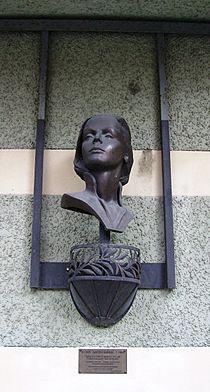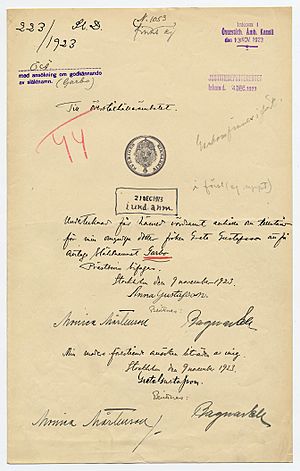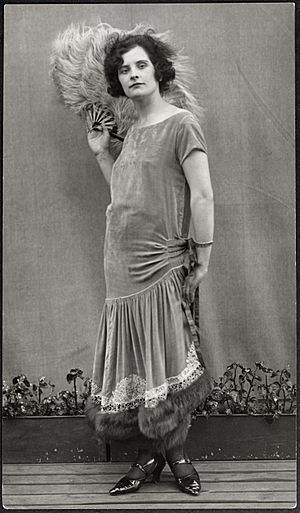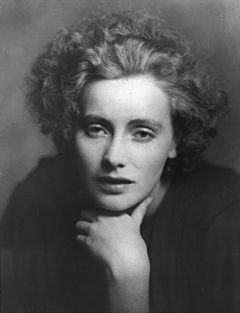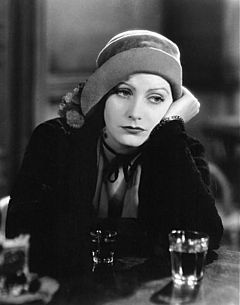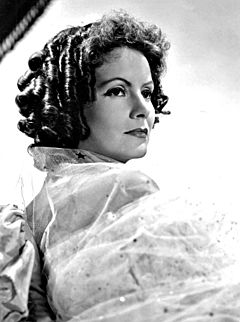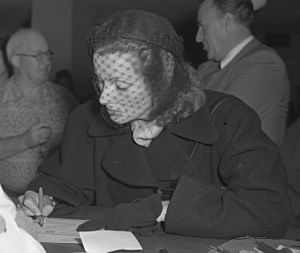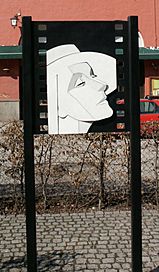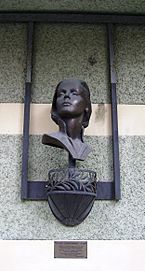Greta Garbo facts for kids
Quick facts for kids
Greta Garbo
|
|
|---|---|

Garbo in Inspiration (1931)
|
|
| Born |
Greta Lovisa Gustafsson
18 September 1905 Stockholm, Sweden
|
| Died | 15 April 1990 (aged 84) New York City, U.S.
|
| Resting place | Skogskyrkogården Cemetery, Stockholm, Sweden |
| Citizenship | Sweden (1905–1951) United States (1951–1990) |
| Occupation | Actress |
| Years active | 1920–1941 |
| Signature | |
Greta Garbo (born Greta Lovisa Gustafsson; 18 September 1905 – 15 April 1990) was a famous actress from Sweden and later the United States. She is known as one of the greatest movie stars of all time. People loved her for her serious and thoughtful characters, and her quiet but powerful acting. In 1999, the American Film Institute named Garbo the fifth greatest female star from the classic Hollywood era.
Greta Garbo started her acting journey in a Swedish film called The Saga of Gösta Berling in 1924. Her acting caught the eye of Louis B. Mayer, who was in charge of Metro-Goldwyn-Mayer (MGM) studios. He brought her to Hollywood in 1925. Her first American silent film, Torrent (1926), made people notice her. Her third movie, Flesh and the Devil (1927), made her a star around the world. By 1928, she was MGM's top box-office star. Other popular silent films she made include The Mysterious Lady (1928) and The Kiss (1929).
When movies started having sound, MGM promoted her first "talkie" film, Anna Christie (1930), with the famous phrase "Garbo talks!" That same year, she also starred in Romance. She was nominated for an Academy Award for Best Actress for both films. By 1932, she was so successful that she could choose her own movie roles. She continued to star in big films like Mata Hari (1931), Grand Hotel (1932), and Queen Christina (1933).
Many experts believe her best performance was as Marguerite Gautier in Camille (1936), which earned her another Academy Award nomination. Her career slowed down for a bit, but she made a comeback with the comedy Ninotchka (1939), earning her a third Academy Award nomination. However, after her film Two-Faced Woman (1941) didn't do well, she decided to stop acting at age 35. She had made 28 films. In 1954, Greta Garbo received a special Academy Honorary Award for her amazing and unforgettable acting. After she retired, Garbo chose to live a very private life and never returned to acting. She also became a collector of beautiful art.
Contents
Early Life in Sweden
Greta Lovisa Gustafsson was born in Södermalm, Stockholm, Sweden, on September 18, 1905. She was the youngest of three children. Her mother, Anna, worked in a jam factory, and her father, Karl, was a laborer. Greta had an older brother, Sven, and an older sister, Alva. For the first ten years of her life, people called her "Kata" because that's how she said her own name.
Greta's family was not wealthy. They lived in a small apartment in a working-class area of Stockholm. As a child, Greta was shy and loved to daydream. She didn't enjoy school much and preferred to play by herself. However, she was a natural leader and loved theater from a young age. She would direct her friends in pretend plays and dreamed of becoming an actress. She also took part in amateur theater. Greta finished school at 13, which was common for working-class girls in Sweden then. She later felt a bit insecure because she didn't go to high school.
In 1919, the Spanish flu spread through Stockholm. Greta's father became very ill and lost his job. Greta took care of him and took him to the hospital every week. He passed away in 1920 when she was only 14 years old.
Becoming a Star
Early Jobs and First Roles (1920–1924)

Greta Garbo's first job was working in a barber shop. Then, she worked at the PUB department store, running errands and helping in the hat section. She started modeling hats for the store's catalogs. Later, she got a better job as a fashion model at Nordiska Kompaniet. In 1920, a director who made commercials for the store chose Greta to appear in ads for women's clothing. Her first commercial came out in December 1920. In 1922, director Erik Arthur Petschler noticed her and gave her a small part in his comedy film, Peter the Tramp.
From 1922 to 1924, Greta studied acting at the Royal Dramatic Training Academy in Stockholm. In 1924, a Finnish director named Mauritz Stiller chose her for a main role in his film The Saga of Gösta Berling. This movie was based on a famous book by Nobel Prize winner Selma Lagerlöf. Stiller became her mentor, teaching her how to act for films and helping her career. After Gösta Berling, she starred in a German film called Die freudlose Gasse (Joyless Street, 1925).
There are different stories about how Greta Garbo got her first contract with Louis B. Mayer from Metro-Goldwyn-Mayer. One story says Mayer was interested in Stiller, but Stiller insisted that Garbo be part of any deal. Mayer saw her film and was amazed by her. Another story says Mayer was interested in Garbo from the start. Either way, he was very impressed by her eyes and knew she could be a big star.
Silent Film Stardom (1925–1929)
In 1925, Greta Garbo, who couldn't speak English yet, came to Hollywood from Sweden. She and Stiller arrived in New York and waited for months to hear from MGM. They decided to go to Los Angeles on their own. Still, weeks passed without contact from the studio. Greta was almost ready to go back to Sweden.
Finally, a friend helped her get a screen test with MGM production boss Irving Thalberg. The test was amazing! Thalberg was very impressed. He immediately started preparing her for stardom, helping her with her teeth, losing weight, and giving her English lessons. As she became a star, Thalberg decided that Garbo would play strong, worldly women in her films.
Even though she hoped to work with Stiller on her first American film, she was cast in Torrent (1926). The movie was a success, and people loved Garbo's acting. Her success led Thalberg to cast her in The Temptress (1926). Her mentor, Stiller, was supposed to direct, but he had trouble working in Hollywood and was replaced. Even though The Temptress was expensive to make, it was a big hit, and MGM had a new star.
After becoming famous so quickly, Garbo made eight more silent films, and all of them were very popular. She starred in three of these with the leading actor John Gilbert.
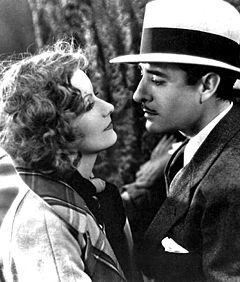
Her third movie with Gilbert, A Woman of Affairs (1928), made her MGM's top star, even more popular than the long-time silent film queen Lillian Gish. Garbo's acting and presence on screen quickly made her known as one of Hollywood's greatest actresses. Film experts say she brought a new level of subtle expression to silent acting. She could show deep feelings with just a slight change in her eyes or mouth.
During this time, Garbo started asking for special conditions on her movie sets. She didn't allow visitors, even studio bosses, and wanted black screens around her to keep others from watching her. She said, "If I am by myself, my face will do things I cannot do with it otherwise."
Even though she was a huge silent film star, the studio worried that her Swedish accent might be a problem for sound films. They delayed her move to "talkies" as long as possible. Garbo's last silent film, The Kiss (1929), was also MGM's last silent movie. Despite their fears, Garbo became one of the biggest stars of the next ten years.
Talking Pictures and Continued Success (1930–1939)
In late 1929, MGM cast Garbo in Anna Christie (1930), which was her first speaking role. The film opened in New York City in February 1930 with the famous slogan "Garbo talks!" It was the highest-earning film of the year. Garbo was nominated for an Academy Award for Best Actress for her performance. Her nomination also included her role in Romance (1930). The success of Anna Christie proved that Garbo could be a star in "talkies." She was ranked the most popular female star in the United States in 1930 and 1931.
Garbo then starred in two of her most famous roles. She played the German spy in Mata Hari (1931). The next year, she played a Russian ballerina in Grand Hotel (1932), which won the Academy Award for Best Picture. Both films were MGM's top earners in their years. Garbo was called "the greatest money-making machine ever put on screen." Her worldwide popularity, known as "Garbomania," was at its highest.
After almost a year of talks, Garbo agreed to a new contract with MGM. She insisted on starring in Queen Christina (1933) and getting a higher salary. For her co-star, she chose John Gilbert. Queen Christina was a big production and a huge success. It was promoted as "Garbo returns" and became the highest-earning film of 1933.
While her popularity in the US was still strong, her films after Queen Christina relied more on international success. During the Great Depression, American audiences preferred American movie couples. Garbo chose to star in Anna Karenina (1935), another famous role. Her acting won her an award from the New York Film Critics. The film did very well internationally.
Garbo then picked the romantic drama Camille (1936). This film was a big international success, her first major hit in three years. She won another New York Film Critics award and was nominated for an Academy Award. Garbo considered Camille her favorite film.
Her next film, Conquest (1937), was a big movie for MGM, but it didn't do well at the box office. In 1938, some stars, including Garbo, were labeled "Box Office Poison" because their films weren't making enough money.
To help Garbo's career, MGM decided she needed a change. For her next movie, they paired her with director Ernst Lubitsch for Ninotchka (1939), her first comedy. The film was a satire about the Soviet Union. Ninotchka opened in October 1939 with the slogan "Garbo laughs!" It was a hit with critics and audiences in the US and abroad.
Last Film and Retirement (1941–1948)
With Two-Faced Woman (1941), MGM tried to make Garbo a modern, chic woman. She played a "double" role and even danced the rhumba. The film received bad reviews. Two-Faced Woman was her last film. She was 36 years old and had made 28 movies in 16 years.
Even though she was upset by the bad reviews, Garbo didn't plan to retire at first. But her films relied on the European market, which was affected by World War II. It was hard to find the right movie for her. She signed a deal in 1942 for a film called The Girl from Leningrad, but the project didn't happen. She still thought she might return to acting after the war, but she was unsure. Her friend Salka Viertel said in 1945, "Greta is eager to work. But on the other side, she's afraid of it." Garbo also worried about her age. Director George Cukor said that Garbo "just gave up. She didn't want to go on."
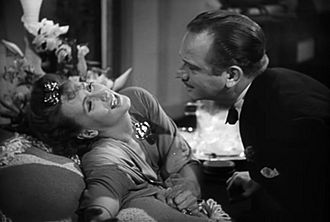
In 1948, Garbo signed a contract to make a film based on a book by Balzac. She did several screen tests and went to Rome in 1949 to film. However, the money for the project didn't come through, and it was canceled. These screen tests were the last time Garbo was in front of a movie camera. They were thought to be lost for 41 years but were found in 1990.
She was offered many roles after retiring but turned almost all of them down. When she did accept, even small problems made her quit. She never told friends why she retired, but four years before she died, she told a Swedish writer, "I was tired of Hollywood. I did not like my work. I really wanted to live another life."
Her Public Image
From the start of her career, Greta Garbo avoided Hollywood parties and social events. She preferred to be alone or with close friends. She never signed autographs, answered fan mail, or gave many interviews. She also never went to the Oscar ceremonies, even when she was nominated. Her dislike for publicity was real, and it often frustrated the studio. In 1928, she explained that she had always wanted to be alone, even as a child. "I detest crowds, don't like many people," she said.
Because Garbo didn't trust the media and often disagreed with MGM, she didn't follow Hollywood's publicity rules. The press often called her the "Swedish Sphinx" because she was so quiet and mysterious. Her shyness and fear of strangers made her seem even more mysterious, both on screen and in real life. MGM eventually used this to their advantage, as it made her seem like a silent, mysterious woman. Even though she tried hard to avoid publicity, Garbo became one of the most talked-about women of her time. She is famous for a line from her film Grand Hotel: "I want to be alone; I just want to be alone." This idea of wanting to be alone was a running theme in her movies.
Garbo is also known for making the "slouchy hat" popular. Her style was often described as wearing a trench coat, simple shoes, shirts, cigarette pants, a slouchy hat, and big sunglasses.
Her Life After Acting
Retirement Years
After retiring, Greta Garbo lived a private life that was simple and relaxed. She didn't make public appearances and carefully avoided the publicity she disliked. She had many friends and often traveled with them.
She sometimes felt unsure about what to do with her time and often felt a bit sad or moody. As she got older, she told a friend, "In a few days, it will be the anniversary of the sorrow that never leaves me." She also said, "I suppose I suffer from very deep sadness." She once said, "I am very happy one moment, the next there is nothing left for me."
Starting in the 1940s, she began collecting art. Her collection included works by famous artists like Renoir and Bonnard. When she passed away in 1990, her art collection was worth millions of dollars.
On February 9, 1951, she became a citizen of the United States. In 1953, she bought a seven-room apartment in Manhattan, New York City, where she lived for the rest of her life.
Greta Garbo was a dinner guest at the White House on November 13, 1963, just nine days before the assassination of President Kennedy. Her niece said Garbo always remembered it as a "magical evening."
In her later years, Garbo became very close to her cook and housekeeper, Claire Koger, who worked for her for 31 years. "We were very close—like sisters," Koger said.
Throughout her life, Garbo was known for taking long walks every day, either with friends or by herself. In retirement, she walked the streets of New York City, dressed casually and wearing large sunglasses. People often tried to spot her, but she remained mysterious until the end.
Close Relationships
Greta Garbo never married and did not have any children. She lived alone as an adult. Her most well-known close friendship was with her frequent co-star John Gilbert. They spent time together in 1926 and 1927. Gilbert helped her with her acting skills and how to handle being a star. They starred together in three more successful films. Gilbert reportedly asked her to marry him many times, but Garbo always changed her mind at the last moment. She said, "I was close to him. But I froze. I was afraid he would tell me what to do and boss me. I always wanted to be the boss."
In 1937, Garbo met orchestra conductor Leopold Stokowski, and they had a well-known friendship while traveling in Europe. In 1941, she met George Schlee, who became her close companion and advisor until his death in 1964.
Death
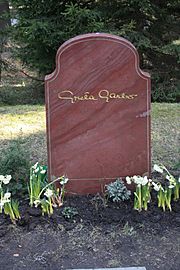
Greta Garbo was treated for breast cancer in 1984. Towards the end of her life, only her closest friends knew she was receiving dialysis treatments for her kidneys. A photo appeared in the media in early 1990, showing her housekeeper helping Garbo, who was using a cane, into the hospital.
Greta Garbo passed away on April 15, 1990, at the age of 84. She died in the hospital from pneumonia and kidney failure.
Garbo was cremated in Manhattan. Nine years later, in 1999, her ashes were buried in the Skogskyrkogården Cemetery, south of her hometown of Stockholm, Sweden.
Greta Garbo had made many investments, mostly in stocks and bonds. She left all of her money, about $32 million, to her niece.
Her Lasting Impact
Greta Garbo was a global star during the late silent film era and the "Golden Age" of Hollywood. She became a true movie icon. For most of her career, she was the highest-paid actor or actress at MGM. After she passed away, the Los Angeles Times called her "the most alluring, vibrant and yet aloof character to grace the motion-picture screen." The Washington Post said that "at the peak of her popularity, she was a virtual cult figure."
Garbo's acting was very subtle and natural, which made her stand out from other actors of her time. Film critic Ty Burr said, "This was a new kind of actor—not the stage actor who had to play to the far seats, but someone who could just look and with her eyes literally go from rage to sorrow in just a close-up."
Film expert Jeffrey Vance said that Garbo showed her characters' deepest feelings through her movements, gestures, and especially her eyes. With just a tiny movement of her eyes, she could show complex feelings. Director Clarence Brown, who made seven of her films, said, "Garbo has something behind the eyes that you couldn't see until you photographed it in close-up. You could see thought."
Many critics say that while not all of Garbo's 24 Hollywood films were artistic masterpieces, her powerful and captivating performances usually made up for any weaknesses in the story or dialogue. As one writer put it, "All moviegoers demanded of a Garbo production was Greta Garbo."
Film historian Ephraim Katz said: "Of all the stars who have ever fired the imaginations of audiences, none has quite projected a magnetism and a mystique equal to Garbo."
American actress Bette Davis said: "Her instinct, her mastery over the machine, was pure witchcraft. I cannot analyze this woman's acting. I only know that no one else so effectively worked in front of a camera."
Mexican actress Dolores del Río called her: "The most extraordinary woman (in art) that I have encountered in my life."
American director George Cukor said: "She had a talent that few actresses or actors possess. In close-ups, she gave the impression, the illusion of great movement. She would move her head just a little bit, and the whole screen would come alive."
American actor Gregory Peck said: "If you ask me my favorite actress of all time, I will tell you that it is Greta Garbo. She shared her emotions with the camera and the audience. They were very truthful emotions."
Documentaries About Garbo
Greta Garbo has been the subject of several documentaries:
- Garbo (1969), BBC, narrated by Joan Crawford
- The Divine Garbo (1990), TNT, narrated by Glenn Close
- Greta Garbo: The Mysterious Lady (1998), Biography Channel, narrated by Peter Graves
- Greta Garbo: A Lone Star (2001), AMC
- Garbo (2005), TCM, narrated by Julie Christie
Garbo in Art and Books
Greta Garbo has been remembered in art and literature. The French composer Charles Koechlin included her in his "Seven Stars Symphony" (1933), with each part dedicated to a Hollywood star.
Author Ernest Hemingway wrote about an imaginary Garbo in his novel For Whom the Bell Tolls (1940).
She was played by Betty Comden in the film Garbo Talks (1984). This movie is about a dying fan who wants to meet Garbo.
A statue of Greta Garbo called "Statue of Integrity" is located in the forest in Härjedalen, Sweden.
Garbo is mentioned in songs like "Break My Soul" by Beyoncé and "Vogue" by Madonna. She is also in the 1977 song "Right Before Your Eyes" by Ian Thomas and "Celluloid Heros" by The Kinks (1972).
Awards and Honors
Greta Garbo was nominated three times for the Academy Award for Best Actress. In 1930, she was nominated for her work in both Anna Christie and Romance. She lost to Norma Shearer. In 1937, Garbo was nominated for Camille, but Luise Rainer won. Finally, in 1939, Garbo was nominated for Ninotchka, but Vivien Leigh won for Gone With the Wind. However, in 1954, she received a special Academy Honorary Award for her "luminous and unforgettable screen performances." As expected, Garbo did not attend the ceremony, and the award was mailed to her home.
Garbo won the New York Film Critics Circle Award for Best Actress twice: for Anna Karenina in 1935 and for Camille in 1936. She also won the National Board of Review Best Acting Award for Camille (1936), Ninotchka (1939), and Two-Faced Woman (1941). In January 1937, she received the Swedish royal medal Litteris et Artibus, given to people who have made important contributions to culture. In 1950, a Daily Variety poll voted Garbo "Best Actress of the Half Century." In 1957, she received The George Eastman Award for her important contributions to film.
In November 1983, King Carl XVI Gustaf of Sweden made her a Commander of the Swedish Order of the Polar Star. In 1985, the Swedish government gave her the Illis quorum medal. In 1985, a star was named after her by the International Star Registry. For her contributions to movies, she received a star on the Hollywood Walk of Fame in 1960.
Garbo appears on several postage stamps. In September 2005, the United States Postal Service and Swedish Posten released two special stamps with her image. On April 6, 2011, the Sveriges Riksbank announced that Garbo's picture would be on the 100-krona banknote starting in 2014–2015.
Filmography
| Year | Title | Role | Notes |
|---|---|---|---|
| 1920 | Mr. and Mrs. Stockholm Go Shopping | Elder sister | An advertisement. |
| 1921 | A Fortune Hunter | Extra | Uncredited; lost film |
| 1921 | Our Daily Bread | Companion | An advertisement |
| 1922 | Peter the Tramp | Greta | Garbo's first part in a commercial film |
| 1924 | The Saga of Gosta Berling | Elizabeth Dohna | Garbo's first main role in a full-length film |
| 1925 | The Joyless Street | Greta Rumfort | |
| 1926 | Torrent | Leonora Moreno aka La Brunna | Garbo's first American film. All of Garbo's later movies were made in Hollywood by Metro-Goldwyn-Mayer. |
| 1926 | The Temptress | Elena | |
| 1926 | Flesh and the Devil | Felicitas | The first of seven Garbo films directed by Clarence Brown, and first of four movies with co-star John Gilbert |
| 1927 | Love | Anna Karenina | Based on the novel Anna Karenina by Tolstoy |
| 1928 | The Divine Woman | Marianne | The film is lost; only a small part still exists. |
| 1928 | The Mysterious Lady | Tania Fedorova | |
| 1928 | A Woman of Affairs | Diana Merrick Furness | The first of seven Garbo films with actor Lewis Stone. |
| 1929 | Wild Orchids | Lillie Sterling | |
| 1929 | A Man's Man | Herself | Garbo and John Gilbert make short appearances; this film is lost. |
| 1929 | The Single Standard | Arden Stuart Hewlett | |
| 1929 | The Kiss | Irene Guarry | Garbo's, and MGM's, last silent picture |
| Year | Title | Role | Notes |
|---|---|---|---|
| 1930 | Anna Christie | Anna Christie | Nominated – Academy Award for Best Actress |
| 1930 | Romance | Madame Rita Cavallini | Nominated – Academy Award for Best Actress |
| 1930 | Anna Christie | Anna Christie | MGM's German version of Anna Christie was also released in 1930 |
| 1931 | Inspiration | Yvonne Valbret | |
| 1931 | Susan Lenox (Her Fall and Rise) | Susan Lenox | |
| 1931 | Mata Hari | Mata Hari | After the multi-star Grand Hotel, Garbo's highest-grossing film |
| 1932 | Grand Hotel | Grusinskaya | Academy Award for Best Picture |
| 1932 | As You Desire Me | Zara aka Marie | The first of three Garbo films with co-star Melvyn Douglas |
| 1933 | Queen Christina | Queen Christina | |
| 1934 | The Painted Veil | Katrin Koerber Fane | |
| 1935 | Anna Karenina | Anna Karenina | New York Film Critics Circle Award for Best Actress |
| 1936 | Camille | Marguerite Gautier | New York Film Critics Circle Award for Best Actress National Board of Review Best Acting Award Nominated – Academy Award for Best Actress |
| 1937 | Conquest | Countess Marie Walewska | |
| 1939 | Ninotchka | Nina Ivanovna "Ninotchka" Yakushova | National Board of Review Best Acting Award Nominated – Academy Award for Best Actress Nominated – New York Film Critics Circle Award for Best Actress |
| 1941 | Two-Faced Woman | Karin Borg Blake / Katherine Borg | National Board of Review of Motion Pictures Best Acting Award |
See also
 In Spanish: Greta Garbo para niños
In Spanish: Greta Garbo para niños
- Category:Cultural depictions of Greta Garbo
- Category:Images of Greta Garbo
- List of actors with two or more Academy Award nominations in acting categories
- List of Academy Award records – first Nordic to be nominated for acting, in Anna Christie (1930)


